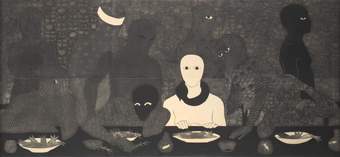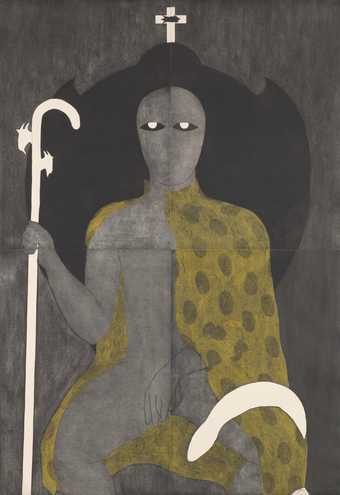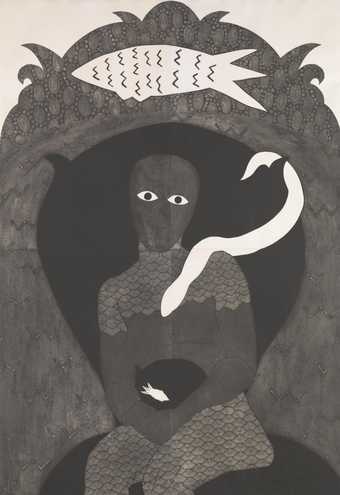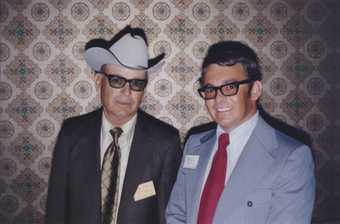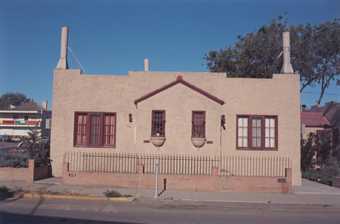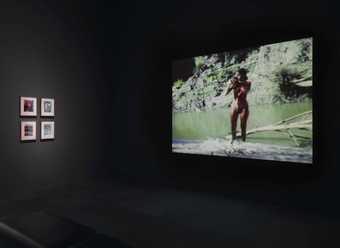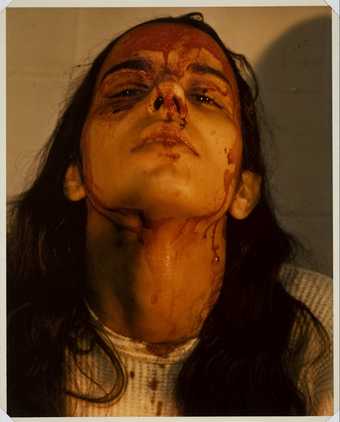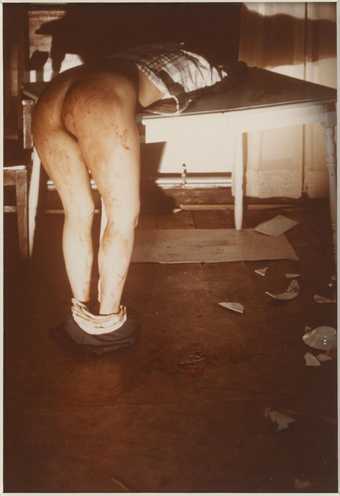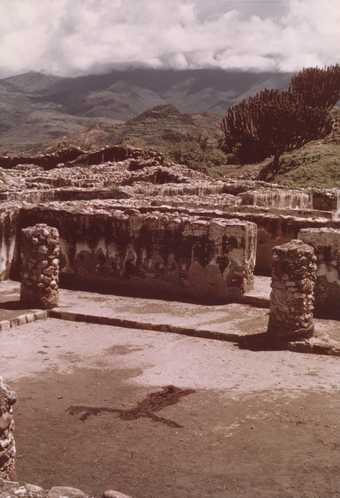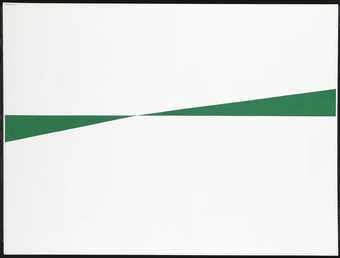
Not on display
- Artist
- Ana Mendieta 1948–1985
- Medium
- Photograph, colour on paper
- Dimensions
- Support: 255 × 203 mm
- Collection
- Tate
- Acquisition
- Presented by the American Patrons of Tate, courtesy of the Latin American Acquisitions Committee 2010
- Reference
- T13356
Summary
This is a colour photograph looking into an alcove set in the wall of a building. A human figure made of interwoven twigs is fixed in the centre of the alcove. It appears to hang against the stone and plaster wall at the back of the alcove, with its arms upraised and its feet disappearing into nothing. Delicate and stylised, the figure has a swollen belly and the suggestion of the curves of a breast and a buttock, as though it is female and twisted slightly towards its right. Mendieta fashioned the silhouette form, following the contours of her own body, from burned thorny twigs, before fixing it in the niche of a building located in the church and monastery complex of Cuilapán de Guerrero, near the city of Oaxaca in Mexico. This sixteenth-century basilica constructed by Dominican friars during the era of the Spanish colonisation of Mexico was the site of several untitled works from Mendieta’s Silueta series in 1973, 1974 and 1976, including an imprint of her body in red on a white sheet hung in the same alcove above an arrangement of dried yucca stalks (reproduced Ana Mendieta: Earth Body, Sculpture and Performance 1972–1985, p.161). Mendieta also photographed the twig figure balanced on a broken column inside one of the monastery buildings (reproduced Unseen Mendieta, p.90).
As a student on the innovative Intermedia art programme run by Hans Breder at the University of Iowa from 1972 to 1977, Mendieta developed a personal fusion of performance and land art which she termed ‘earth-body work’ and ‘earth-body sculptures’. Her ephemeral landscape interventions, designed to survive only as photographs, are small in scale and firmly rooted to her female body. In a statement she wrote about her work in 1981, she explained:
I have been carrying out a dialogue between the landscape and the female body (based on my own silhouette). I believe this has been a direct result of my having been torn from my homeland (Cuba) during my adolescence. I am overwhelmed by the feeling of having been cast from the womb (nature). My art is the way I re-establish the bonds that unite me to the universe. It is a return to the maternal source. Through my earth/body sculptures I become one with the earth ... I become an extension of nature and nature becomes an extension of my body. This obsessive act of reasserting my ties with the earth is really the reactivation of primaeval beliefs ... [in] an omnipresent female force, the after-image of being encompassed within the womb.
(Quoted in Petra Barreras del Rio and John Perreault, Ana Mendieta: A Retrospective, The New Museum of Contemporary Art, New York 1988, p.10.)
Mendieta was born in Havana, Cuba, into a family of prominent politicians. During the political turmoil of the early 1960s, she and her sister Raquelín were sent – together with many other Cuban children – to the United States under the auspices of Operation Pedro Pan. As a result, Mendieta was shuttled between foster families and an Iowa boarding school from 1961 until 1966, when her mother and brother left Cuba for the US. Having taken a course on Primitive Art as part of her BA (1967–9) at the University of Iowa, Iowa City in 1967, Mendieta visited Mexico for the first time in 1971 while undertaking an archaeology module on her painting MFA (1969–72). However, it was not until she travelled to the valley of Oaxaca with Breder and a group of students from the Intermedia programme in summer 1973 that she connected with Mexico on a personal level, identifying its mixture of indigenous and European cultures with her own hybrid Cuban heritage. She created her first Silueta – Imagen de Yagul (reproduced Ana Mendieta, p.53) – covering her naked body in sprays of white flowers in an open Zapotec tomb in Yagul during this trip. The iconography of Imagen de Yagul and this untitled Silueta heralds a later series of Siluetas that the artist called the Tree of Life (1976–9), featuring her mud-covered body merging with the trunk and roots of trees. Frequently depicted connecting the underworld with the world of the living, the tree of life is a symbol not only of regeneration, but also one of common descent in the evolutionary sense. The sixteenth-century convent of Cuilapán de Guerrero was constructed using materials recycled from the pre-Colombian ruins on which it was built, thus fusing the culture of the Spanish colonists with that of the indigenous Zapotecs who had originally inhabited the region. By coincidence, the Arbol del Tule – one of the oldest and largest trees in the world and symbol of the tree of life – grows nearby in the town of Santa Maria del Tule.
From 1973 until 1980 Mendieta created over a hundred Siluetas in Mexico and Iowa, using such natural materials as earth, blood, flowers, leaves, sticks and stones as well as fire, gunpowder, fireworks, candles and cloth. Legs are rarely differentiated in the Siluetas and the figures appear either with their arms raised in the manner of the Minoan snake goddess – as in Tate’s two Silueta
images – or with them held close to the body. Where the artist’s body features, it is usually buried, relating to the Mexican preoccupation with death, still visible in its Day of the Dead celebrations and more historically in the traditions of ritual sacrifice belonging to many Mesoamerican cultures.
Mendieta documented her earth-body works with 35mm colour slides, from which she made unique prints, of which this is one.
Further reading:
Peter Fisher (ed.), Patrick Dondelinger and Laura Routlet, Ana Mendieta: Body Tracks, exhibition catalogue, Kunstmuseum Luzern 2002, reproduced p.121.
Olga M Viso, Ana Mendieta: Earth Body, Sculpture and Performance 1972–1985, exhibition catalogue, Hirshhorn Museum and Sculpture Garden, Smithsonian Institution, Washington DC 2004, pp.78–9, reproduced p.79.
Olga Viso, Unseen Mendieta: The Unpublished Works of Ana Mendieta, Munich, Berlin, London and New York 2008, p.79, reproduced p.79.
Elizabeth Manchester
October 2009
Does this text contain inaccurate information or language that you feel we should improve or change? We would like to hear from you.
Explore
- emotions and human qualities(5,345)
-
- identity(10)
- photographic(4,673)
- weaving(13)
- environment / nature(315)
- history(1,983)
- transformation(186)
- countries and continents(17,390)
-
- Mexico(73)
- education, science and learning(1,416)
-
- archaeology(107)
- cultural identity(7,943)
- colonialism(429)
You might like
-
Belkis Ayón The Supper
1991 -
Belkis Ayón Mokongo
1992 -
Belkis Ayón Sikán
1991 -
Stephen Shore Tucumcari, New Mexico, July 1972
1972, printed 2005 -
Stephen Shore Clovis, New Mexico, June 1972
1972, printed 2005 -
Stephen Shore Clovis, New Mexico, June 1972
1972, printed 2014 -
Stephen Shore Farmington, New Mexico, June 1972
1972, printed 2005 -
Stephen Shore Farmington, New Mexico, June 1972
1972, printed 2005 -
Stephen Shore Gallup, New Mexico, July 1972
1972, printed 2005 -
Ana Mendieta Blood Feathers
1974 -
Ana Mendieta Untitled (Self-Portrait with Blood)
1973 -
Ana Mendieta Untitled (Rape Scene)
1973 -
Ana Mendieta Untitled (Silueta Series, Mexico)
1974 -
Carmen Herrera White and Green
1959 -
Ana Mendieta Grass Breathing
c.1974

